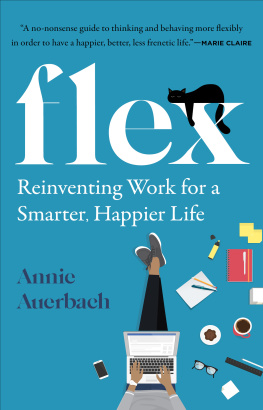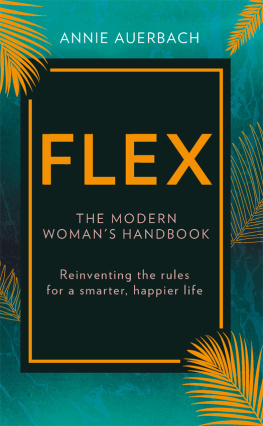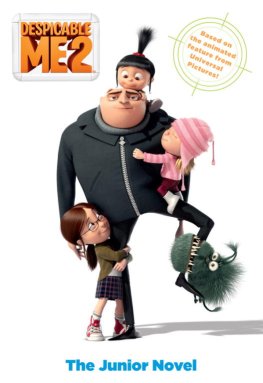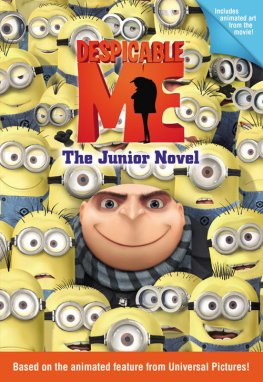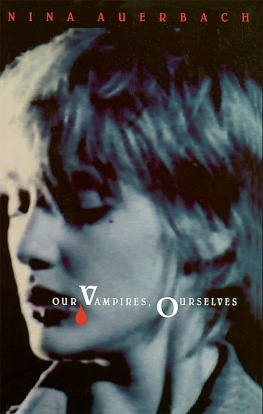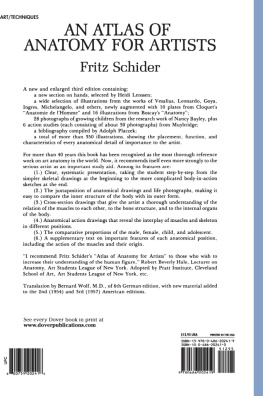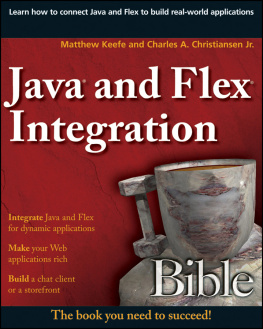Annie Auerbach - Flex
Here you can read online Annie Auerbach - Flex full text of the book (entire story) in english for free. Download pdf and epub, get meaning, cover and reviews about this ebook. year: 2020, publisher: HarperOne, genre: Home and family. Description of the work, (preface) as well as reviews are available. Best literature library LitArk.com created for fans of good reading and offers a wide selection of genres:
Romance novel
Science fiction
Adventure
Detective
Science
History
Home and family
Prose
Art
Politics
Computer
Non-fiction
Religion
Business
Children
Humor
Choose a favorite category and find really read worthwhile books. Enjoy immersion in the world of imagination, feel the emotions of the characters or learn something new for yourself, make an fascinating discovery.
- Book:Flex
- Author:
- Publisher:HarperOne
- Genre:
- Year:2020
- Rating:5 / 5
- Favourites:Add to favourites
- Your mark:
- 100
- 1
- 2
- 3
- 4
- 5
Flex: summary, description and annotation
We offer to read an annotation, description, summary or preface (depends on what the author of the book "Flex" wrote himself). If you haven't found the necessary information about the book — write in the comments, we will try to find it.
Flex — read online for free the complete book (whole text) full work
Below is the text of the book, divided by pages. System saving the place of the last page read, allows you to conveniently read the book "Flex" online for free, without having to search again every time where you left off. Put a bookmark, and you can go to the page where you finished reading at any time.
Font size:
Interval:
Bookmark:
TO DARLING CLEMMY,
BIBI & BEN
F lex is a manifesto for living and working on your terms. It means looking at the established, rigid ways of doing things and asking: Is this really working for me? If the answer to that question is No, then read on, because this book is for you.
When we learn how to flex, we gain a superpower that allows us to challenge what is holding us back and to reinvent the rules for a smarter, happier life. Things are changing for women across the globe. We are getting married and having children later, if at all. Dual-income families have replaced the traditional template of man as breadwinner and woman as homemaker. Technology allows us to work differently and understand ourselves better.
But the old systems still persist. Were continually bashing up against inflexible structures that were built by, and for, men. We are trying to do everything while following a rule book we didnt write.
Cartoons of working women depict us as harassed multitaskers with eight octopus arms, juggling food, lipstick, laptop, and wine. Who actually wants to live their lives like this? Who wants to be a jittery octopus lady constantly time-pressed and on the verge of meltdown? Not me.
Ive been thinking about flex for a long time. Ive worked flexibly for 20 years in many different guisespart-time, remote working, through a portfolio career, and freelancing. I am now 42, I run my own business, and I have two daughters under 10, a husband, and a small snappy dogso I am right in the eye of the storm.
In 2016, I founded a cultural insight agency called Starling with my business partner, Adam. At Starling, we help brands understand how society is changing, so they can be more relevant. We speak to the smartest academics and the most radical thinkers. We ask Why?; we listen for whats being ignored; we help our clients build better futures. And so I decided to use this approach to look at the old structures that are restricting us and come up with shiny new solutions. Researching how women are working and living today turned out to be an awakening for me.
I have encountered a huge number of people who have found different ways to flex. These pioneers of flexible working may have initially been motivated by the need to manage childcare and responsibilities at home as well as progressing in their careers, but they are also unrecognized revolutionaries who have been chipping away at the systems that society has outgrown. They refuse to accept the status quo, they challenge handed-down wisdom, and they change the game for the rest of us. Quite simply, they are phenomenal, and we need to learn from them. In each chapter, Ive featured a story from one of these pioneering flexers.
I wrote this book because Im inspired by them, and I think the image of stressed, juggling womanhood is past its sell-by date. I dont want to join the army of exhausted octopus women, desperately hashtagging #wineoclock and marching under the banner of having it all. I dont want to be told I have to be good at everything, all of the time: friendship, leadership, parenting, Pilates, makeup, public speaking, cake baking, even tennis. Its exhausting, its not cool, and Im over it.
More and more businesses in different sectors are recognizing the fundamental importance of creativity in their employees, whatever their role, yet we seem to be funneling ourselves into tighter and more restrictive routines and thinking patterns. When we prioritize the wrong thingslike long working hours over friendships, exams over mental agility, climbing the established career ladder over cutting our own pathswe diminish and inhibit ourselves and our possibilities. Similarly, when we ignore our bodies moods and cycles, going against the grain of how we feel or what we really want, then we can only really feel like were failing, living half-lives.
Flex is a creative, rebellious, badass way to live because it means looking at routines like the nine-to-five and social norms like women bearing the brunt of the emotional load at home, and bending and reshaping them. When you flex, you invent your own template, according to your own ambitions and your familys needs, often without precedent on a truly blank slate.
So to flex we need to be brave. We need to take a long look within and ask, How can I work to the best of my abilities at work, while being the mother or partner or friend I want to be at home? And once weve figured out what exactly flex means for us as individuals, we have to find the confidence to go out there and ask for it. Even when it goes against our current climate of pointless meetings, presenteeism, the strictures of nine-to-five, and even societys expectations on us as women. And I want to show you how. The five chapters of this book ask what the concept of flex looks like through different lenses: work, yes, but also our minds, our homes, our bodies, and finally our futures.
We know that the world is changing fast. Rigidity in a world of change means something is going to break, and that something could be you. And think about it: many of the jobs we were trained for in school wont exist in a decade. The more robotic our behavior, the more vulnerable we are to the robots taking our place. So flex has to be, for all of us, a movement built on creativity, bravery, anti-convention, and innovation.
When we learn to flex, we reinvent the rules for a new future, and its one in which we can all thrive.
M y day job is coming up with fresh thinking and new ideas for brands. I love ideas. I love the first sniff of one, the gut feeling were onto something. The hunt for more evidence and the inevitable period of doubt and being lost in the forest. The joy of getting it down on paper. I love all of it.
Flex is about inventing new answers to old problems and picking at the threads of handed-down wisdom to see what unravels. It means having a low boredom threshold for the same old, same old. It makes us challenge the status quo and ask difficult questions, like: Is this the way we should be living and working? Are the norms weve all bought into making us happy? This is the opposite of dogma and rigidity. It is a sort of cognitive yoga, an exercise for the mind that stretches our horizons and challenges our biases. It requires bravery, leaps of faith, and empathy. And, annoyingly, its not easy...
SKILL OF THE FUTURE
The World Economic Forum predicts that creativity is one of the top three skills workers will need in the future. The other two are complex problem-solving and critical thinking. The more we flex our creativity muscles, they say, the more we future-proof our skills.
Some days at work, my partner Adam and I are creative ninjas. Other days, we talk about last nights TV shows and what were going to have for lunch. Creativity isnt effortless, theres no app for it, but its vital if we are to find new and exciting ways to change the things that are restricting us. In this chapter, Ill dig into the key ingredients for creativity, so that we can unlock it in ourselves. I will look at how our environments have conspired against us to make us inflexible, and Ill show how we can foster the right conditions for creativity to thrive.
Today, whether youre a coffee barista or a CEO, everyone hungers to be creative. The New Yorker dubs it Creativity Creep, saying: Few qualities are more sought after, few skills more envied. Everyone wants to be more creativehow else, we think, can we become fully realized people?
Part of this is because we have more time to spend on being creative. As Walter Pitkin observed back in 1932, thanks to medical breakthroughs and time-saving devices like washing machines, men and women alike turn from the ancient task of
Font size:
Interval:
Bookmark:
Similar books «Flex»
Look at similar books to Flex. We have selected literature similar in name and meaning in the hope of providing readers with more options to find new, interesting, not yet read works.
Discussion, reviews of the book Flex and just readers' own opinions. Leave your comments, write what you think about the work, its meaning or the main characters. Specify what exactly you liked and what you didn't like, and why you think so.

